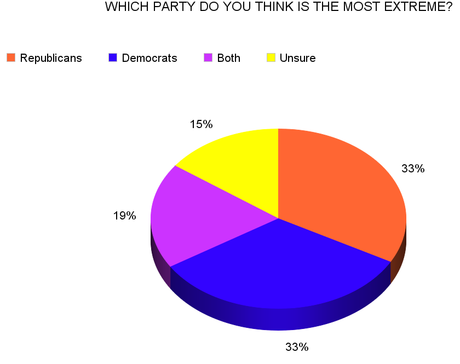


A majority of the public (52%) sees both political parties as being extreme. That's not true. Many of us left-wingers would like to see more liberal views from the Democratic Party, but that's not likely to happen, with a moderate in the White House (Obama) and an only slightly more liberal candidate set to replace him (Clinton). But I can understand why the public, most of whom don't pay much attention to politics until an election draws near, might think that.
What the public sees is a Congress that can't get anything accomplished because of a failure to compromise on any issue. It is natural that those without much political knowledge would think it is because both parties were holding to extremist ideologies. But the truth is that this is happening because only one of those parties is holding an extremist ideology -- the Republicans. They are the ones refusing to compromise at all.
But it could get even worse. When asked what they want their party to do in the next few years, only 26% of Democrats wanted their party to become more liberal. But 46% of Republicans want their party to move even further to the right -- even though most of their elected officials are already further to the right than before the Great Depression.
This explains why the Democrats are happy to nominate an only slightly to the left of center candidate for president in 2016 (Hillary Clinton), while the Republicans seem set to nominate a far-right ideologue (with even their most "moderate" candidates being well to the right of any other candidate they have nominated since World War II).
These charts were made from a YouGov Poll done between February 25th and 27th of a random national sample of 1,000 adults, with a margin of error of 4 points.

